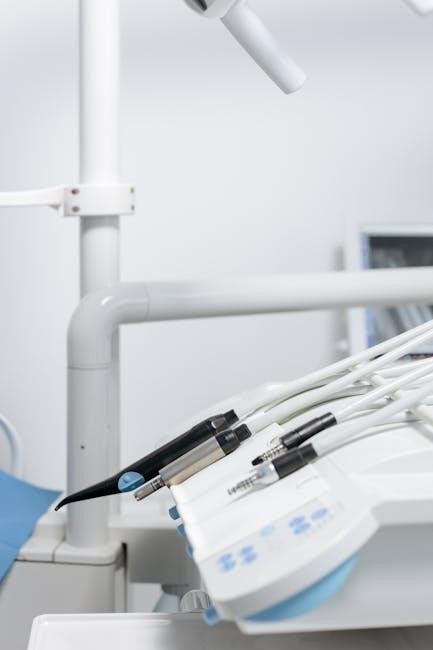Dental instruments are essential tools for diagnosing and treating dental conditions. Understanding their names‚ functions‚ and proper use is crucial for effective patient care. This guide provides a comprehensive overview‚ including detailed descriptions‚ images‚ and resources like PDF manuals to help professionals and students master dental instrumentation.
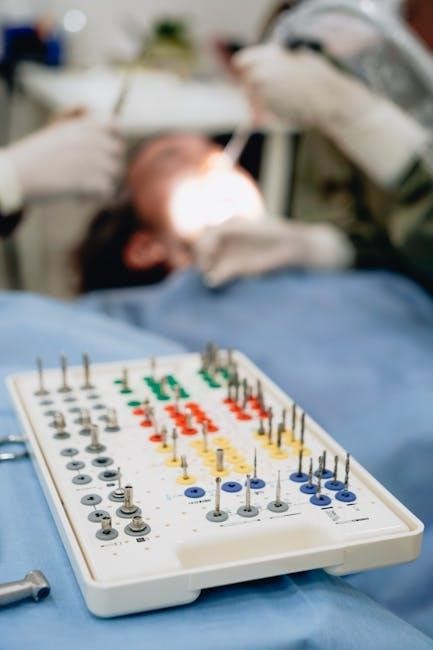
Overview of Dental Instruments
Dental instruments encompass a wide range of tools designed for specific tasks in dentistry‚ from basic examinations to complex surgical procedures. They are categorized into groups such as diagnostic‚ hygiene‚ restorative‚ and surgical instruments. Each tool has unique features‚ materials‚ and functions‚ ensuring precision and efficiency in patient care. Understanding these instruments is vital for dental professionals to deliver effective treatments. Proper sterilization and handling of instruments are emphasized to maintain patient safety. Resources like PDF guides and online platforms provide detailed descriptions‚ images‚ and usage instructions‚ aiding both professionals and students in mastering dental instrumentation. This overview highlights the diversity and importance of dental tools in modern dentistry.
Importance of Knowing Dental Instrument Names and Functions
Recognizing dental instrument names and functions is fundamental for effective communication and patient care. Accurate identification ensures proper tool selection‚ enhancing treatment outcomes and efficiency. It also fosters clear communication among dental teams‚ reducing errors. For students and professionals‚ understanding instruments aids in mastering procedures and staying updated with advancements. Resources like PDF guides and visual manuals provide essential details‚ making learning accessible and practical. Proficiency in naming and describing instruments is a cornerstone of professional competence‚ enabling precise documentation and informed decision-making in clinical settings.
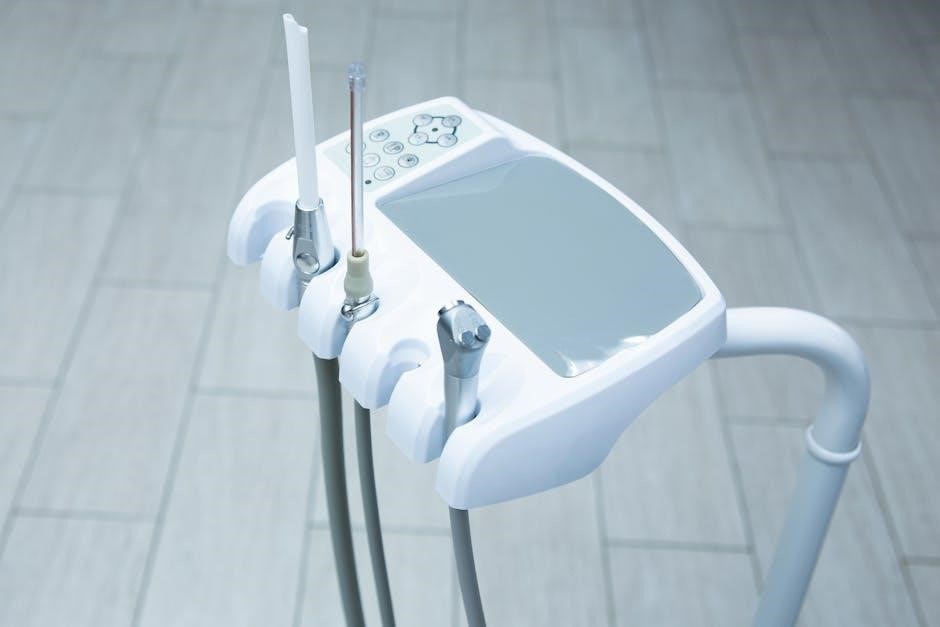
Basic Dental Instruments
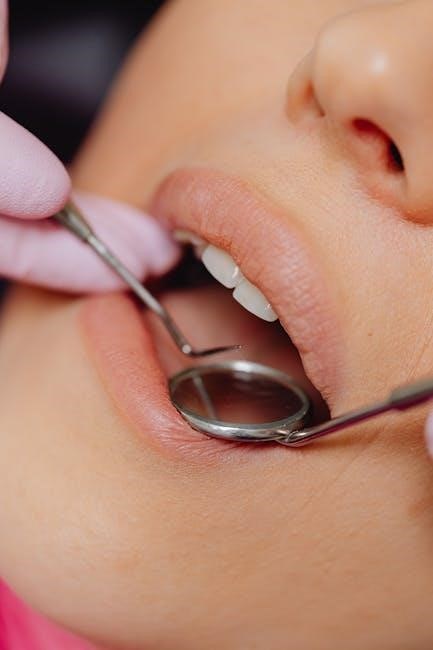
Basic dental instruments are foundational tools used in daily dental practices. They include items like dental trays‚ mirrors‚ probes‚ chisels‚ and hand files. A PDF guide provides detailed images and names‚ aiding in identification and understanding for both professionals and students.
Dental Tray: Function and Characteristics
The dental tray serves as a specialized container for organizing and holding dental instruments during procedures. Its design ensures easy access and prevents contamination. Available in various sizes‚ it features compartments to keep tools tidy. Durability and sterility are key characteristics. A PDF guide provides images and names‚ helping professionals and students identify and use it effectively in clinical settings. Proper tray setup is essential for efficient dental operations. This tool is indispensable in maintaining organization and hygiene during dental treatments. Its functionality supports smooth workflow‚ making it a cornerstone in dental practice. Understanding its role enhances overall patient care and procedural efficiency.
Dental Mirror: Uses in Examination and Procedures
The dental mirror is a fundamental tool for indirect visualization in oral examinations. It allows dentists to view areas inaccessible to the naked eye‚ such as the posterior surfaces of molars. Its curved surface provides a clear reflection‚ aiding in diagnosing conditions like cavities or fractures. During procedures‚ the mirror helps in precise placement of restorations and removal of plaque. It also reflects light‚ improving visibility in deep pockets. Available in different sizes‚ it ensures comfort and accuracy. A PDF guide with images and names highlights its variations and proper handling techniques. The dental mirror is indispensable for thorough examinations and efficient treatment‚ enhancing patient care and procedural outcomes significantly.
Dental Probe: Measuring Pocket Depths
The dental probe is a vital instrument for assessing periodontal health by measuring pocket depths around teeth. It features graduated markings‚ typically in millimeters‚ allowing precise measurements to diagnose conditions like gingivitis or periodontitis. The probe is gently inserted into the gingival sulcus to evaluate the depth and detect any abnormalities. Proper technique ensures accurate readings without causing patient discomfort. Regular use aids in monitoring disease progression and treatment effectiveness. PDF guides‚ such as the DentalInstrumentsPicturesAndNames‚ provide detailed images and descriptions of various probes‚ highlighting their role in comprehensive oral examinations and procedures. Accurate pocket depth measurements are essential for developing effective treatment plans and maintaining patient oral health.
Chisels: Removing Excess Tooth Structure
Dental chisels are essential tools used to remove excess tooth structure during various procedures. They are typically made of high-quality stainless steel for durability and precision. Chisels come in different shapes and sizes‚ with straight or angled blades‚ each designed for specific applications. They are commonly used in restorative dentistry to reshape teeth‚ prepare surfaces for fillings‚ or remove decay. Proper technique ensures minimal trauma to the tooth and surrounding tissue. PDF guides‚ such as the DentalInstrumentsPicturesAndNames‚ provide detailed images and descriptions of chisels‚ helping professionals and students identify and understand their use in clinical settings. Accurate handling of chisels is crucial for achieving optimal dental outcomes and patient comfort.
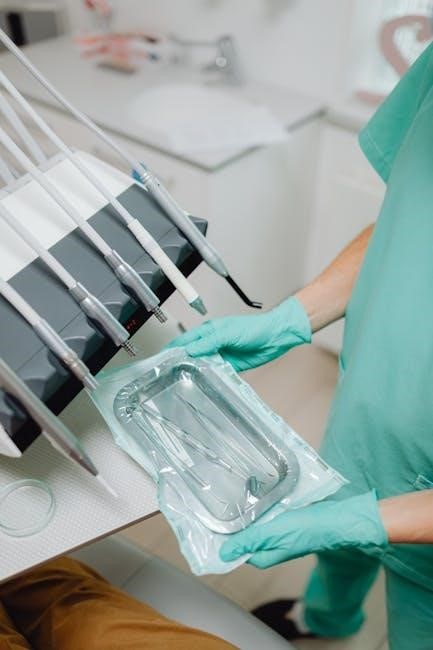
Hygiene and Cleaning Instruments
Hygiene instruments are vital for maintaining oral health. They include scalers for removing plaque and tartar‚ ultrasonic devices for deep cleaning‚ and hand files for smoothing surfaces.
Hand Files: Smoothing Tooth Surfaces
Hand files are essential dental tools used to smooth and refine tooth surfaces. They come in various types‚ such as diamond or carbide files‚ each designed for specific applications. These instruments are commonly used during cavity preparation‚ restorative procedures‚ or enamel shaping. Hand files are available in different grits‚ ranging from coarse to fine‚ allowing for precise adjustments. Proper sterilization and maintenance are crucial to ensure longevity and effectiveness. They are often used manually or with a rotary drill‚ depending on the procedure. Hand files play a vital role in achieving smooth‚ polished surfaces‚ enhancing both functionality and aesthetics in dental care.

Scalers: Removing Plaque and Tartar
Scalers are dental instruments designed to remove plaque and tartar from teeth‚ both above and below the gum line. They are essential for maintaining oral hygiene and preventing conditions like periodontal disease. Available in various types‚ such as ultrasonic or hand scalers‚ they are used in professional dental cleanings to ensure deep and thorough removal of harmful deposits. Ultrasonic scalers use high-frequency vibrations‚ while hand scalers are manually operated‚ offering precision for delicate areas. Regular use of scalers helps maintain gum health‚ prevents inflammation‚ and ensures a clean dental environment. Proper technique and sterilization are critical to ensure effective and safe use of these instruments.
Ultrasonic Devices: Advanced Cleaning
Ultrasonic devices are advanced tools used in dental hygiene for deep cleaning and removing plaque‚ tartar‚ and stains. These devices emit high-frequency vibrations‚ creating a gentle yet effective cleaning action. They are commonly used in professional dental cleanings to target areas below the gum line and interdental spaces. Ultrasonic scalers are a popular type‚ offering precision and efficiency. They are particularly useful for patients with periodontal disease or heavy tartar buildup. Regular use of ultrasonic devices helps prevent gum inflammation‚ promotes healthy gums‚ and maintains fresh breath. Proper training is essential for effective and safe application‚ ensuring optimal results in dental hygiene procedures.
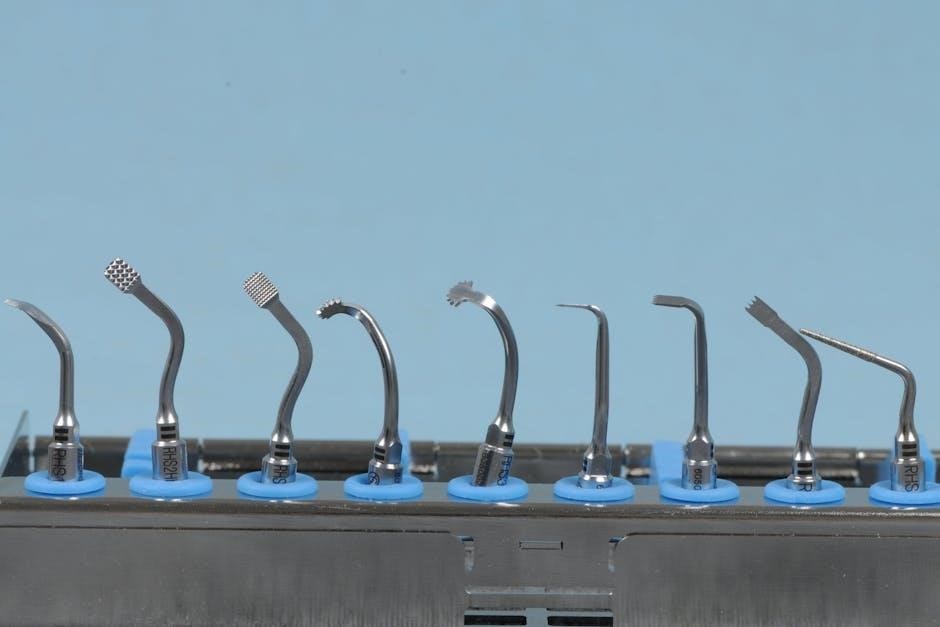
Carving and Finishing Instruments
These tools‚ including chisels‚ hand files‚ and burs‚ are used to shape and refine tooth structures. They ensure precise adjustments for optimal aesthetics and functionality in dental restorations.
Burs: Shaping Tooth Structure
Burs are essential dental instruments used for shaping and modifying tooth structures. Available in various types‚ such as diamond and carbide burs‚ they are designed for precise removal of enamel‚ dentin‚ or restorative materials. Diamond burs are highly durable and effective for cutting hard tissues‚ while carbide burs are sharper and ideal for fine detailing. Both types are commonly used in restorative and surgical procedures. Proper selection and use of burs ensure efficient tooth preparation‚ minimizing damage to surrounding tissues. Regular maintenance‚ such as sterilization and replacement‚ is crucial for optimal performance. Burs are indispensable in achieving accurate and aesthetic results in dental treatments.
Hand Instruments: Detailing and Polishing
Hand instruments are crucial for detailing and polishing dental restorations‚ ensuring smooth surfaces and precise finishes. Commonly used tools include files‚ hoes‚ and scalers‚ each designed for specific tasks. These instruments are typically made from high-quality stainless steel‚ offering durability and resistance to wear. Files are used to refine and shape surfaces‚ while hoes and scalers remove plaque‚ tartar‚ or excess material. Proper technique and maintenance are essential to prolong their effectiveness. Regular sterilization and storage in protective cases prevent damage and ensure optimal performance. Hand instruments are versatile‚ allowing for fine adjustments and polishing‚ making them indispensable in both general and specialized dental procedures. Their use requires skill and precision to achieve desired aesthetic and functional outcomes.
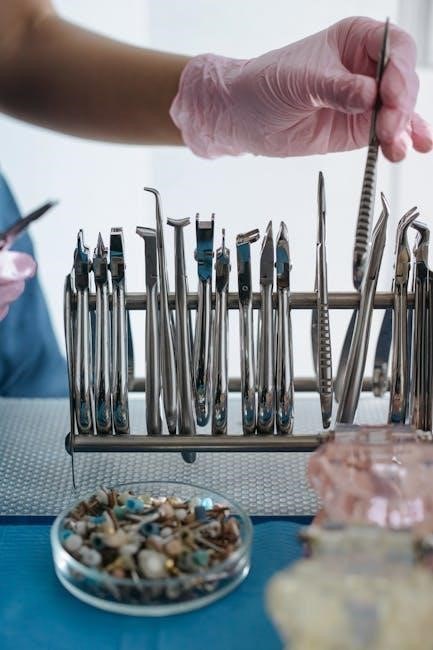
Surgical and Specialty Instruments
Surgical and specialty instruments are designed for advanced dental procedures‚ precision‚ and complexity. They include tools like forceps‚ retractors‚ and the Apollo Gauge‚ ensuring optimal surgical outcomes.
Forceps: Handling and Placing Restorations
Forceps are essential dental instruments used for handling and placing restorations‚ such as amalgam or composite fillings. They are designed with precise tips to grip small objects securely. Available in various types‚ forceps ensure accurate placement and minimally invasive procedures. Their ergonomic design enhances control‚ reducing fatigue during complex restorations. Proper sterilization and maintenance are critical to ensure optimal performance. Forceps play a vital role in achieving precise and durable restorations‚ making them indispensable in dental practices.
Retractors: Accessing Surgical Sites
Retractors are specialized dental instruments designed to access surgical sites by gently retracting soft tissues. Available in various types‚ such as metal or plastic‚ they provide clear visibility and unobstructed access during procedures. Their curved or angled designs allow precise tissue management‚ minimizing discomfort for patients. Retractors are commonly used in oral surgeries‚ implant placements‚ and periodontal treatments. Proper sterilization and maintenance ensure optimal performance. By enabling better visualization‚ retractors enhance surgical accuracy and efficiency‚ making them indispensable in modern dental practices for achieving successful outcomes.
Apollo Gauge: Measuring Bone Thickness
The Apollo Gauge is a specialized dental instrument designed to measure bone thickness without requiring tissue incision. Its calibrated scale allows for precise readings‚ making it invaluable in surgical procedures. Commonly used in implantology and orthodontics‚ it helps assess bone density and plan placements accurately. The gauge is designed for easy readability‚ ensuring reliable data collection. Its non-invasive nature minimizes patient discomfort‚ making it a preferred tool for preoperative assessments. Regular sterilization is essential to maintain its effectiveness and safety. The Apollo Gauge is a critical instrument in modern dentistry‚ enabling practitioners to make informed decisions for successful surgical outcomes.
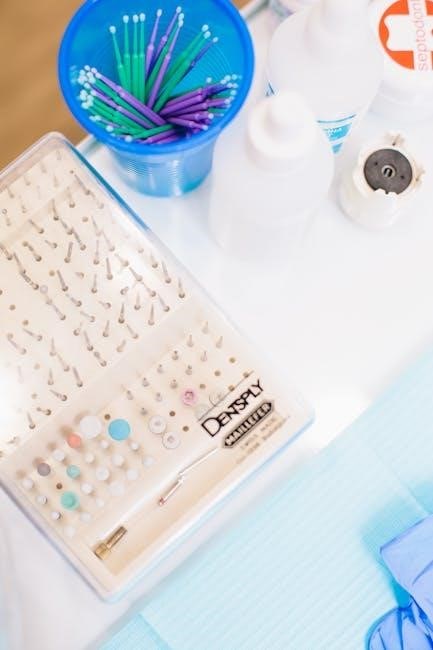
Dental Instrument Photography and Documentation
High-quality images of dental instruments are essential for education‚ diagnosis‚ and treatment planning. Proper lighting and camera settings ensure clarity‚ aiding in accurate documentation and visualization.
Photography Tips for Dental Instruments
Photographing dental instruments requires precision and attention to detail. Use a macro lens for clear images‚ ensuring proper lighting to avoid shadows. A clean‚ neutral background enhances focus on the instrument. Experiment with angles to highlight key features. Use a tripod for stability and consider using a reflector for even illumination. Editing software can enhance clarity but avoid over-processing. Consistency in style helps create a professional visual guide. Refer to resources like DentalInstrumentsPicturesAndNames PDF for examples and inspiration. High-quality images aid in education‚ diagnosis‚ and documentation‚ making them indispensable for dental professionals and students alike.
Creating a Visual Guide with Pictures
A visual guide with pictures is an invaluable resource for understanding dental instruments. Include high-quality images of instruments like chisels‚ hand files‚ and burs‚ each labeled with their names and functions. Organize the guide by instrument categories‚ such as basic‚ hygiene‚ or surgical tools‚ for easy navigation. Use consistent lighting and backgrounds to maintain a professional appearance. Refer to resources like DentalInstrumentsPicturesAndNames PDF for inspiration and accuracy. This guide will aid in education‚ clinical decision-making‚ and documentation‚ making it a essential tool for dental professionals and students. Ensure images are clear and well-detailed to enhance learning and practical application.
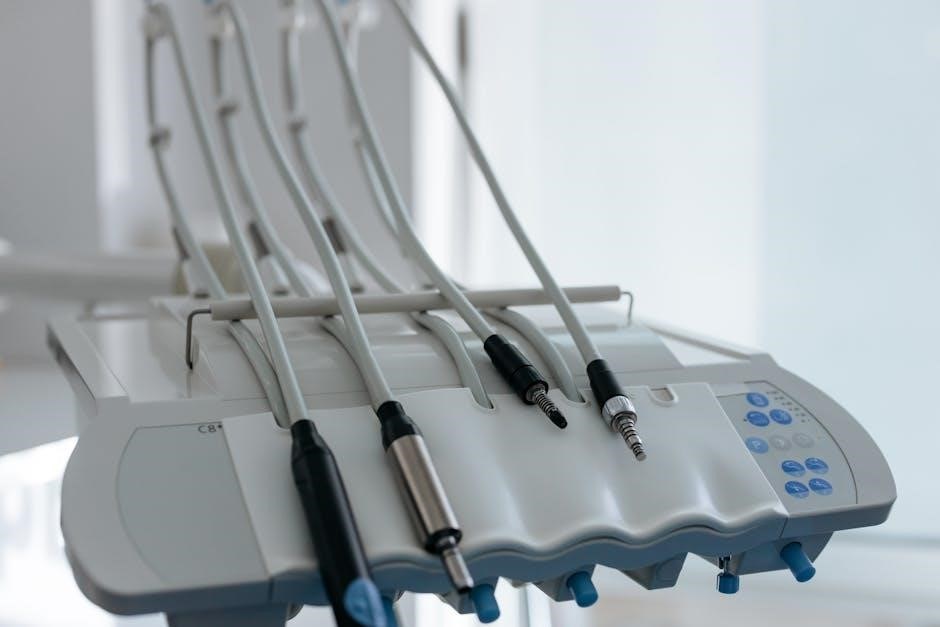
Resources for Dental Instrument Information
Access comprehensive guides like DentalInstrumentsPicturesAndNames PDF for detailed images and descriptions. Online platforms offer manuals‚ catalogs‚ and downloadable resources to enhance knowledge of dental tools and their uses.
PDF Guides and Manuals
PDF guides and manuals are invaluable resources for understanding dental instruments. They provide detailed images‚ names‚ and descriptions‚ helping professionals and students master instrumentation. These documents often include categorized lists of tools‚ their functions‚ and usage tips. For example‚ the DentalInstrumentsPicturesAndNames PDF offers a visual and descriptive guide to essential instruments. Many manuals are available for free download on educational and professional platforms‚ making them accessible for learning and reference. These resources are especially beneficial for training programs‚ ensuring comprehensive knowledge of dental tools. They serve as a bridge between theoretical learning and practical application‚ enhancing proficiency in dental care and procedures.
Online Platforms for Downloading Resources
Online platforms are excellent hubs for accessing dental instrument resources‚ including PDF guides and manuals. Websites like Nacinon Technologies and educational repositories offer free downloads of detailed documents. These platforms provide comprehensive guides with images and names of instruments‚ catering to both students and professionals. For instance‚ the DentalInstrumentsPicturesAndNames PDF is widely available on such sites. They also feature manuals from various dental disciplines‚ ensuring a broad understanding of tools and their applications. These resources are easily accessible‚ making them invaluable for educational purposes and practical reference. They support continuous learning and professional development in dentistry‚ ensuring up-to-date knowledge and skills.
